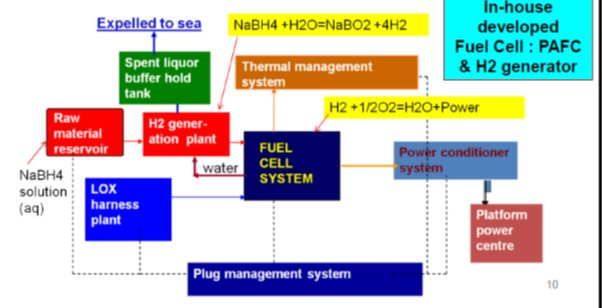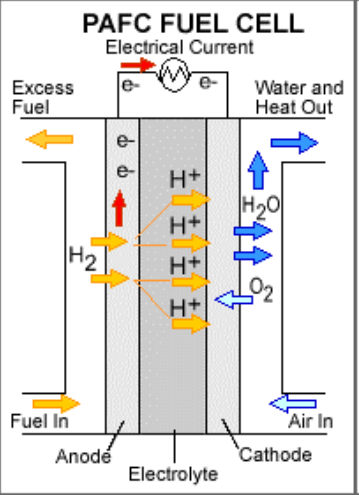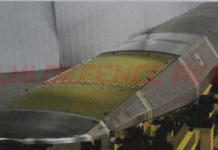It seems a decision has been taken by the Indian Navy (IN) to install an air-independent propulsion (AIP) system developed by the Naval Materials Research Laboratory (NMRL), Ambernath, which is a part of the Defence Research & Development Organization (DRDO), on all six of its Scorpene class diesel-electric submarines once they become due for their first major refit. This decision is of course contingent upon NMRL’s AIP being fully proven by then as a ‘safe plug’. Given that the refit of even the first Scorpene Class submarine, the INS Kalvari, is not due for at least another six years, NMRL is confident of having refined its already advanced prototype sufficiently by that point, to satisfy IN’s requirements.
The earlier plan of installing NMRL’s AIP on the last two Scorpenes has been given up since NMRL’s AIP plug was not deemed sufficiently mature by the original equipment maker (OEM) of the Scorpene Class, France’s Naval Group, once known as DCNS. As such, it is felt by various stakeholders that it is now too late to install the AIP on the last two Scorpenes which are also at an advanced stage of construction.
However, IN has decided that even though the process of installing the AIP plug during refit will involve cutting open the hull of its Scorpene units, it would still be worth it, given that NMRL’s AIP boasts attractive features. In fact, NMRL believes that its Phosphoric Acid Fuel Cell (PAFC) based AIP solution is a step ahead of what the People’s Liberation Army Navy has obtained from Sweden in the form of a Stirling cycle based AIP for its submarines. Be that as it may, let us take a closer look at NMRL’s 250 kilowatt (kW) PAFC based AIP solution that allows up to 14 days of underwater endurance for a submarine running solely on power supplied by this system. Fig. 1 below gives the overall scheme behind NMRL’s AIP system.
NMRL’s AIP

Fig. 1: Overall scheme of NMRL’s AIP system. Source: NMRL
On-board hydrogen generation
While based on a proven fuel cell technology type i.e PAFC, NMRL’s AIP system, nonetheless, incorporates a set of innovations that make it a rather contemporary system. For one, NMRL’s AIP package has an onboard hydrogen generation plant, which produces hydrogen ‘in situ’ unlike many other AIP configurations where hydrogen for a mission has to be carried on board. Moreover, on board hydrogen production in NMRL’s AIP does not require any kind of combustion. NMRL’s AIP supplies hydrogen ‘in situ’ by reacting hydrogen ‘rich’ sodium borohydride, which is carried on board, with water, to generate hydrogen and sodium metaborate (see Fig. 1, above). The advantages of this kind of ‘borohydride hydrolysis’ (BH) to generate hydrogen vis a vis other forms of on-board hydrogen generation are given below in Fig. 2. NMRL’s BH process generates a considerable amount of hydrogen without entailing the release of any gaseous effluents which add to system noise and can compromise submarine stealth. Moreover, BH plants also have long operational lives.

Fig. 2: A comparison of various on-board hydrogen plant processes. Source: NMRL
PAFC innovation
Now the hydrogen generated by BH is sent to the main power plant of the AIP system which is made up of PAFC stacks, which of course use phosphoric acid as an electrolyte. The electrodes of NMRL’s PAFC design are made of PTFE bonded platinum/ carbon. The electrode support is in the form of carbon paper and silicon carbide serves as the electrolyte support. A typical PAFC layout and process is depicted in Fig. 3 below.

Fig. 3: Typical PAFC layout and operation. Source: NMRL
Basic PAFC technology is actually the oldest commercial grade FC technology in use today. However, the technology has seen constant improvements over the years and retains certain advantages over other FC types. PAFC has much longer service life than any other commercially viable FC type and has much better tolerance to impurities in the reactants used even when compared to polymer electrolyte membrane fuel cells (PEMFC). Naturally, PAFC does have its disadvantages too as compared to PEMFCs and more contemporary FC types. PAFC operating temperatures are usually higher in comparison to PEMFC and overall power to weight ratio is lower. A comparison of PAFC vis a vis other FC types is given in Fig 4 below.

Fig. 4: Comparison of PAFC with other FC types. Source: NMRL
Anyway, PAFC technology has evolved to become a rather useful option for ground based off-grid power supply. What NMRL has done is further develop basic PAFC -related know how to come up with indigenous PAFC stacks that are ruggedized and compact enough to be suitable for underwater marine applications with the relevant safety margins. A typical challenge with PAFCs is the need to handle its corrosive acid electrolyte while maintaining the concentration of the same. This requires the development of special corrosion resistant materials and detailed component engineering, both of which have been accomplished indigenously at NMRL. Indeed, NMRL has registered a number of innovation patents on its way to the development of indigenous PAFC stacks related to the catalysts used, sealants, acid holder matrix, carbon paper, etc. Much headway has also been made on acid management systems. The thrust of development has obviously been on lowering costs since the special materials used in a PAFC are not exactly cheap. For example, NMRL has developed low-cost graphite gas distributor plate materials for use in its PAFC stacks. NMRL has also experimented with special siloxane based microporous gels that enhance water retention to prevent the loss of design life that PAFC’s which have to undergo frequent stop/starts suffer from. NMRL’s PAFC also operates at a lower temperature than older generation PAFCs, apparently. This of course helps reduce the parasitic power load of the AIP system below that of a legacy PAFC based system, with the concurrent benefit of greater net output available for propulsive purposes.
Indigenous production
Importantly, NMRL’s development of indigenous PAFC stacks has been done in close cooperation with Indian industry. In fact, NMRL developed PAFCs are the first examples of successful industrialization of any FC type in India. NMRL has transferred PAFC technology to Thermax Ltd, Pune which began production with the supply of twenty-four 3 kW PAFC units for captive use at NMRL via a buy back arrangement. According to CSIR, Thermax’s facility ‘is provided with all sub-manufacturing modules to manufacture electrodes from basic raw materials, assemble them in the form of fuel cell stacks and conduct elaborate testing of each stack for meeting the strict quality control requirements of NMRL necessary for defence establishments’. It seems that large scale skilled manpower for the manufacture of fuel cells has also been developed in the course of industrializing NMRL’s PAFC technology.
NMRL and Thermax have now graduated to the production of the N11, 11.5 kW marine grade PAFC stack shown below that has a rugged cocoon structure and has passed shock and vibration tests that one may experience during intense underwater operations. Such parallel / series connected PAFC stacks can be used for power generation levels of up to 500 kW, thereby underlining the modularity of NMRL’s AIP solution which can be used in submarines other than the Scorpene as well.

Fig. 5: The N11, a 11.5 kW PAFC stack developed for NMRL’s AIP solution. Source: NMRL
Moreover, NMRL’s modular architecture scores over a composite system, since even if one of the modules fails, the control system for the PAFC stacks can reconfigure the remaining operational units to continue to supply power output, albeit at a reduced quantum. This naturally increases the survivability of the system, which is of utmost importance when being used to propel a submarine stealthily.
For the Scorpene and beyond
The current AIP prototype being tested at NMRL has been optimized for the form and fit of the Scorpene’s hull (see Fig. 6 below), although modules that fit other hull dimensions can be engineered as well.

Fig. 6: NMRL’s AIP plug for the Scorpene Class submarines of the Indian Navy. Source: NMRL
This AIP conforms to the typical standard that its length be less than 10 percent of the hull it is intended for and is a cylindrical plug that is neutrally buoyant and probably weighs less than 300 tons. Obviously, NMRL’s AIP has got no heavy rotating machinery and NMRL is confident that the module ‘maintains relative silence and retains its stealth characteristics’ throughout the platform’s envelope.
As such, the development of an indigenous AIP system by DRDO and its complete domestic industrialization is a significant milestone in the development of FC technology in India. Apart from the Scorpene programme, whatever diesel-electric submarine design is chosen for construction under Project-75I is also likely to be a recipient of NMRL’s AIP solution.
Saurav Jha is the Editor-in-Chief of Delhi Defence Review. Follow him on twitter @SJha1618.
© Delhi Defence Review. Reproducing this content in full without permission is prohibited.
































